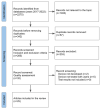Recent Developments in Haptic Devices Designed for Hearing-Impaired People: A Literature Review
- PMID: 36991680
- PMCID: PMC10055558
- DOI: 10.3390/s23062968
Recent Developments in Haptic Devices Designed for Hearing-Impaired People: A Literature Review
Abstract
Haptic devices transmit information to the user, using tactile stimuli to augment or replace sensory input. People with limited sensory abilities, such as vision or hearing can receive supplementary information by relying on them. This review analyses recent developments in haptic devices for deaf and hard-of-hearing individuals by extracting the most relevant information from each of the selected papers. The process of finding relevant literature is detailed using the PRISMA guidelines for literature reviews. In this review, the devices are categorized to better understand the review topic. The categorization results have highlighted several areas of future research into haptic devices for hearing-impaired users. We believe this review may be useful to researchers interested in haptic devices, assistive technologies, and human-computer interaction.
Keywords: haptic devices; hearing impairment; human–computer interaction; sensory substitution systems; vibrotactile feedback; wearable devices.
Conflict of interest statement
The authors declare no conflict of interest.
Figures
Similar articles
-
Audio-Tactile Rendering: A Review on Technology and Methods to Convey Musical Information through the Sense of Touch.Sensors (Basel). 2021 Sep 30;21(19):6575. doi: 10.3390/s21196575. Sensors (Basel). 2021. PMID: 34640895 Free PMC article. Review.
-
Using haptic stimulation to enhance auditory perception in hearing-impaired listeners.Expert Rev Med Devices. 2021 Jan;18(1):63-74. doi: 10.1080/17434440.2021.1863782. Epub 2020 Dec 29. Expert Rev Med Devices. 2021. PMID: 33372550 Review.
-
Haptic Communication of Language.IEEE Trans Haptics. 2023 Apr-Jun;16(2):134-153. doi: 10.1109/TOH.2023.3257539. Epub 2023 Jun 20. IEEE Trans Haptics. 2023. PMID: 37030739 Review.
-
Haptic perception of users with low vision and their needs in haptic-incorporated user interfaces.Disabil Rehabil Assist Technol. 2014 May;9(3):195-208. doi: 10.3109/17483107.2013.769121. Epub 2013 Apr 23. Disabil Rehabil Assist Technol. 2014. PMID: 24749554
-
Tactile Perceptual Thresholds of Electrovibration in VR.IEEE Trans Vis Comput Graph. 2021 May;27(5):2618-2626. doi: 10.1109/TVCG.2021.3067778. Epub 2021 Apr 15. IEEE Trans Vis Comput Graph. 2021. PMID: 33750706
Cited by
-
Sensory-substitution based sound perception using a spinal computer-brain interface.Sci Rep. 2024 Oct 22;14(1):24879. doi: 10.1038/s41598-024-75779-2. Sci Rep. 2024. PMID: 39438593 Free PMC article.
-
A Novel Tactile Learning Assistive Tool for the Visually and Hearing Impaired with 3D-CNN and Bidirectional LSTM Leveraging Morse Code Technology.Bioengineering (Basel). 2025 Mar 3;12(3):253. doi: 10.3390/bioengineering12030253. Bioengineering (Basel). 2025. PMID: 40150717 Free PMC article.
-
Human Factors and Organizational Issues in Health Informatics: Review of Recent Developments and Advances.Yearb Med Inform. 2024 Aug;33(1):196-209. doi: 10.1055/s-0044-1800744. Epub 2025 Apr 8. Yearb Med Inform. 2024. PMID: 40199306 Free PMC article. Review.
-
The Ongoing Challenges of Hearing Loss: Stigma, Socio-Cultural Differences, and Accessibility Barriers.Audiol Res. 2025 Apr 24;15(3):46. doi: 10.3390/audiolres15030046. Audiol Res. 2025. PMID: 40407660 Free PMC article. Review.
-
Exposure to vibrotactile music improves audiometric performances in individuals with cochlear implants.Sci Rep. 2025 Jun 12;15(1):20054. doi: 10.1038/s41598-025-02946-4. Sci Rep. 2025. PMID: 40506478 Free PMC article.
References
-
- World Health Organization Newsroom—Deafness and Hearing Loss. [(accessed on 11 May 2022)]; Available online: https://www.who.int/news-room/fact-sheets/detail/deafness-and-hearing-loss.
-
- World Health Organization Health Topics—Deafness and Hearing Loss. [(accessed on 11 May 2022)]; Available online: https://www.who.int/health-topics/hearing-loss#tab=tab_1.
-
- Taylor J., Mote K. Getting Started with Accessibility and Inclusion. [(accessed on 11 May 2022)]. Available online: https://www.jisc.ac.uk/guides/getting-started-with-accessibility-and-inc....
-
- United Nations United Nations Disability Inclusion Strategy. [(accessed on 11 May 2022)]; Available online: https://www.un.org/en/content/disabilitystrategy/
Publication types
MeSH terms
LinkOut - more resources
Full Text Sources
Medical





